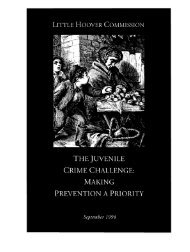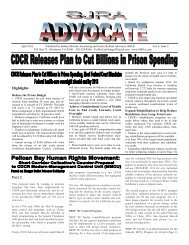Jailhouse Lawyer's Handbook - Sentencing and Justice Reform ...
Jailhouse Lawyer's Handbook - Sentencing and Justice Reform ...
Jailhouse Lawyer's Handbook - Sentencing and Justice Reform ...
You also want an ePaper? Increase the reach of your titles
YUMPU automatically turns print PDFs into web optimized ePapers that Google loves.
“1969” is the year in which the decision was<br />
announced.<br />
If you want to quote from a decision, or refer to<br />
reasoning used in the decision, you will also need to<br />
include the page number where your point appears in<br />
the decision. This is called a “pin cite” or “jump cite.”<br />
In the following example, “485” is the pin cite:<br />
Johnson v. Avery, 393 U.S. 483, 485 (1969)<br />
Sometimes a U.S. Supreme Court decision will be cited<br />
to all three sets of reports, like:<br />
Johnson v. Avery, 393 U.S. 483, 89 S.Ct.<br />
797, 21 L.Ed. 2d 718 (1969).<br />
You can cite all three if you want, but it is usually not<br />
required. Do not give only a “S.Ct.” or L.Ed.” citation<br />
without also giving the U.S. citation, unless the<br />
decision has not yet been reported in U.S. or you<br />
cannot find out its U.S. citation. If this happens, cite the<br />
case as: Johnson v. Avery, ___U.S.___, 89 S.Ct. 747,<br />
21 L.Ed. 2d 718 (1969). If you have only S.Ct.. or only<br />
L.Ed. put what you have after “___U.S.___.”<br />
The Supreme Court Reporter <strong>and</strong> the Lawyer’s Edition,<br />
which are supposed to be in your prison library, usually<br />
give the “U.S.” cite for each decision.<br />
A typical Circuit Court citation is:<br />
U.S. v. Footman, 215 F.3d 145 (1st Cir. 2000)<br />
This decision starts on page 145 of volume 215 of the<br />
Federal Reporter, third series. The information in<br />
parentheses tells you that this decision is from the First<br />
Circuit, <strong>and</strong> that it was decided in the year 2000.<br />
A typical District Court citation is:<br />
Bracewell v. Lobmiller, 938 F. Supp. 1571<br />
(M.D. Ala. 1996)<br />
This decision starts on page 1571 of volume 938 of the<br />
Federal Supplement. It was issued in 1996 by the U.S.<br />
District Court for the Middle District of Alabama.<br />
Unpublished Decisions<br />
Not every district court or circuit court decision is<br />
reported. Some decisions are “unpublished,” which<br />
means they do not appear in the official reporters.<br />
Unfortunately, a lot of cases about prisoners are<br />
unpublished. Not all courts allow you to cite to<br />
unpublished cases, <strong>and</strong> they are very hard for prisoners<br />
to get. To find out whether or not you can use<br />
unpublished cases, look in your district court’s local<br />
rules. If the local rules allow you to use unpublished<br />
cases, look to see if they require the side that uses them<br />
to give copies to the other parties. This is probably the<br />
case, <strong>and</strong> it means that you should dem<strong>and</strong> copies of all<br />
unpublished cases cited in your opponent’s briefs.<br />
A publication called U.S. Law Week, which may be in<br />
the prison law library, prints a few important decisions<br />
by various courts before those decisions appear in<br />
regular reports. You can use a Law Week citation until<br />
the decision appears in a reporter. Use the same general<br />
form as for reported case, but indicate the court, the<br />
case number on the court docket <strong>and</strong> the exact date of<br />
the decision (not just the year). For example:<br />
Oswald v. Rodriguez, 40 U.S.L.W. 3597<br />
(U.S. June 19, 1972) (No. 71-1369).<br />
Sometimes you may learn about a helpful decision<br />
which has not appeared in a Reporter or in U.S. Law<br />
Week. Either the decision has not yet been published or<br />
it is a district court decision which will not be<br />
published. In either situation, you can still give a<br />
citation for the decision. You list the official case<br />
number on the court docket <strong>and</strong> give the exact date of<br />
the decision. For example:<br />
Boothe v. Procunier, No. C-70-1990-ACW<br />
(N.D. Cal. Sept. 29, 1970).<br />
When you want to use a case in a memor<strong>and</strong>um of law<br />
or a brief or any other legal document, you should put<br />
the case cite, as it appears in the examples above, at the<br />
end of every sentence that refers to a fact or a legal rule<br />
or a quote that comes from that case.<br />
This may sound confusing at first, but it is not.<br />
Throughout this h<strong>and</strong>book, there are many examples<br />
that can help you see how this works. For instance, on<br />
page – in Chapter Two, we wrote:<br />
“A prison official cannot censor your mail just<br />
because it makes rude comments about the prison<br />
or prison staff. Bressman v. Farrier, 825 F.Supp.<br />
231 (N.D. Iowa 1993).”<br />
We “cited” the case Bressman v. Farrier because it<br />
supports our statement about censorship of mail. Citing<br />
a case allows the reader to go look up the case for proof<br />
JAILHOUSE LAWYERS HANDBOOK – CHAPTER SIX<br />
71





